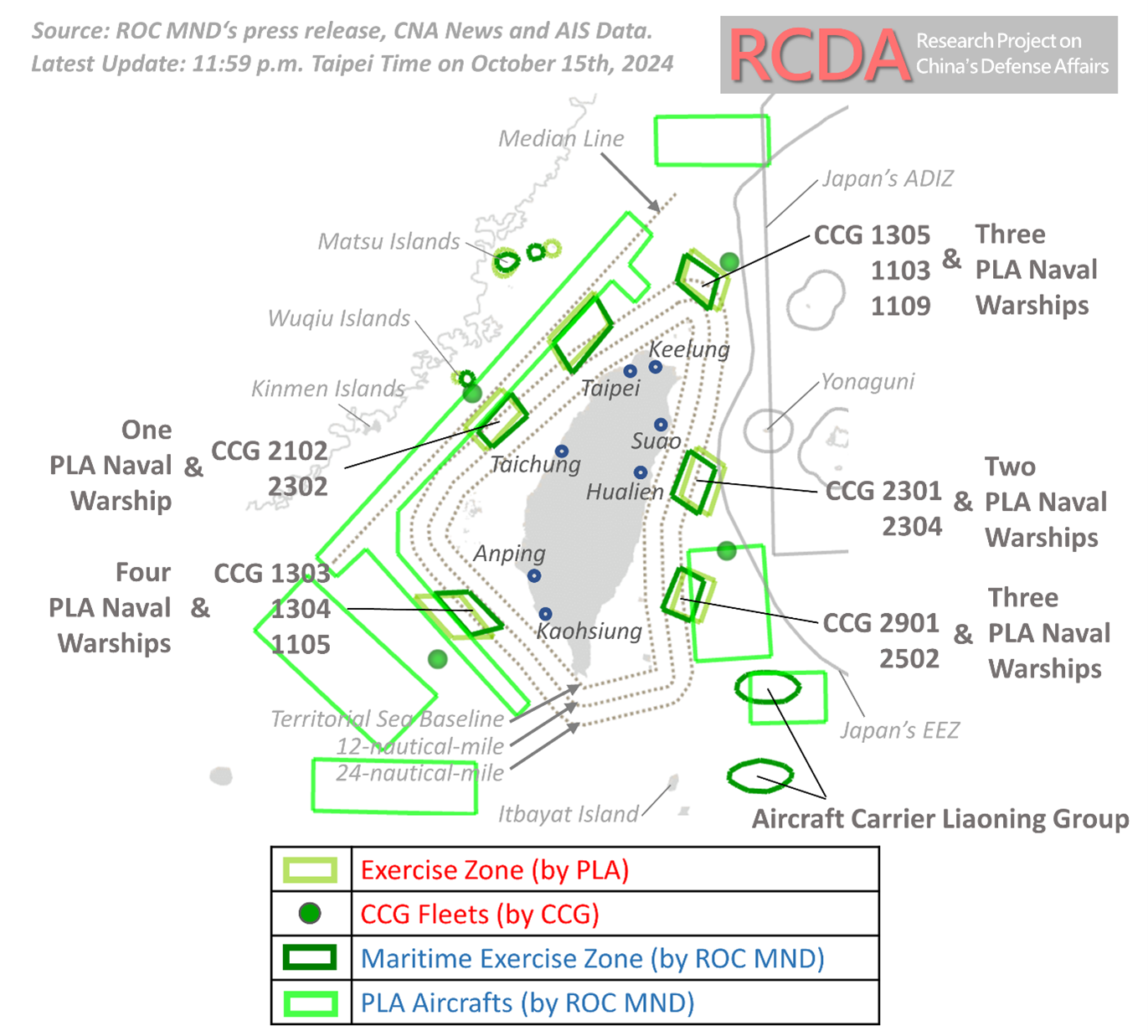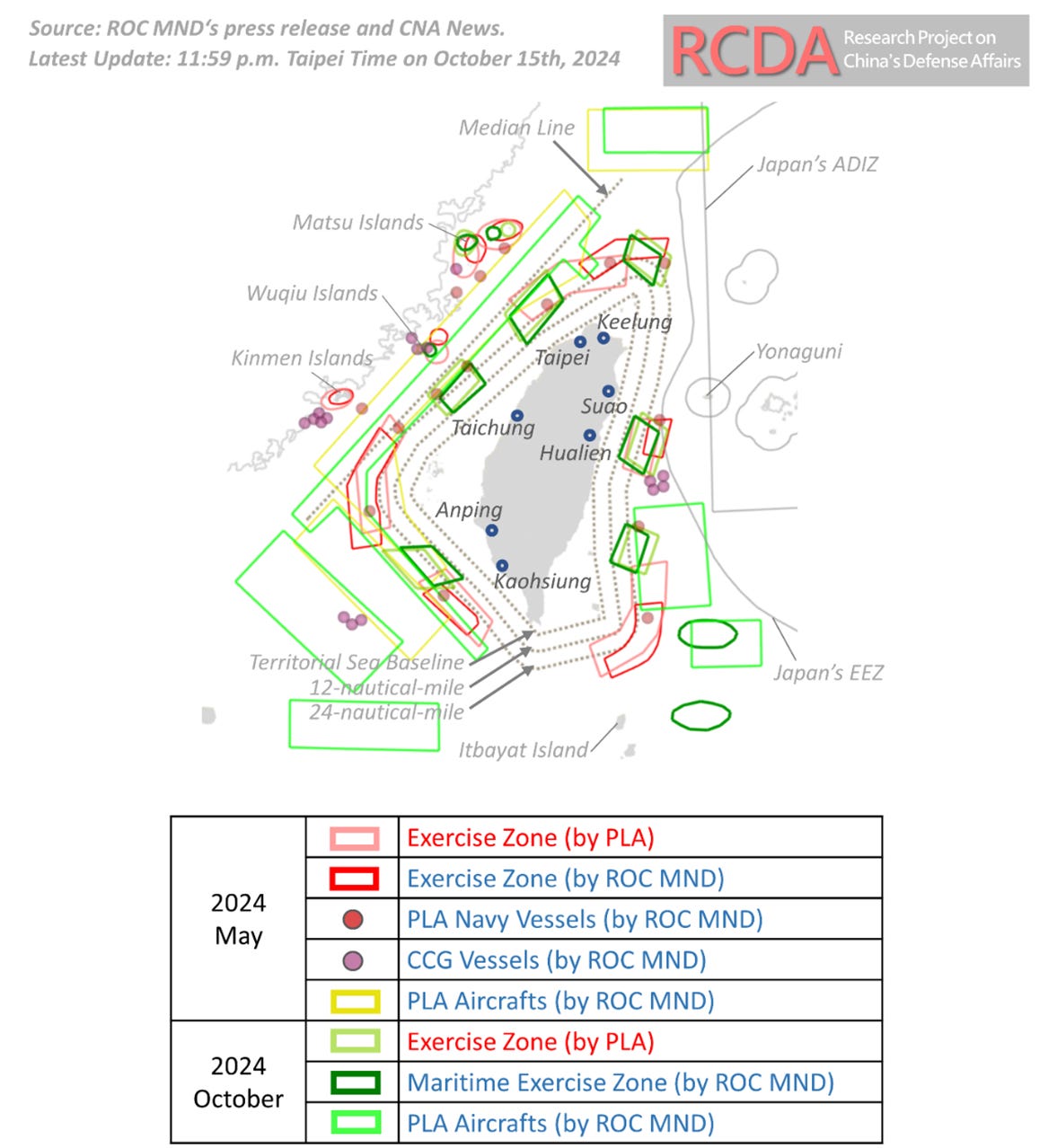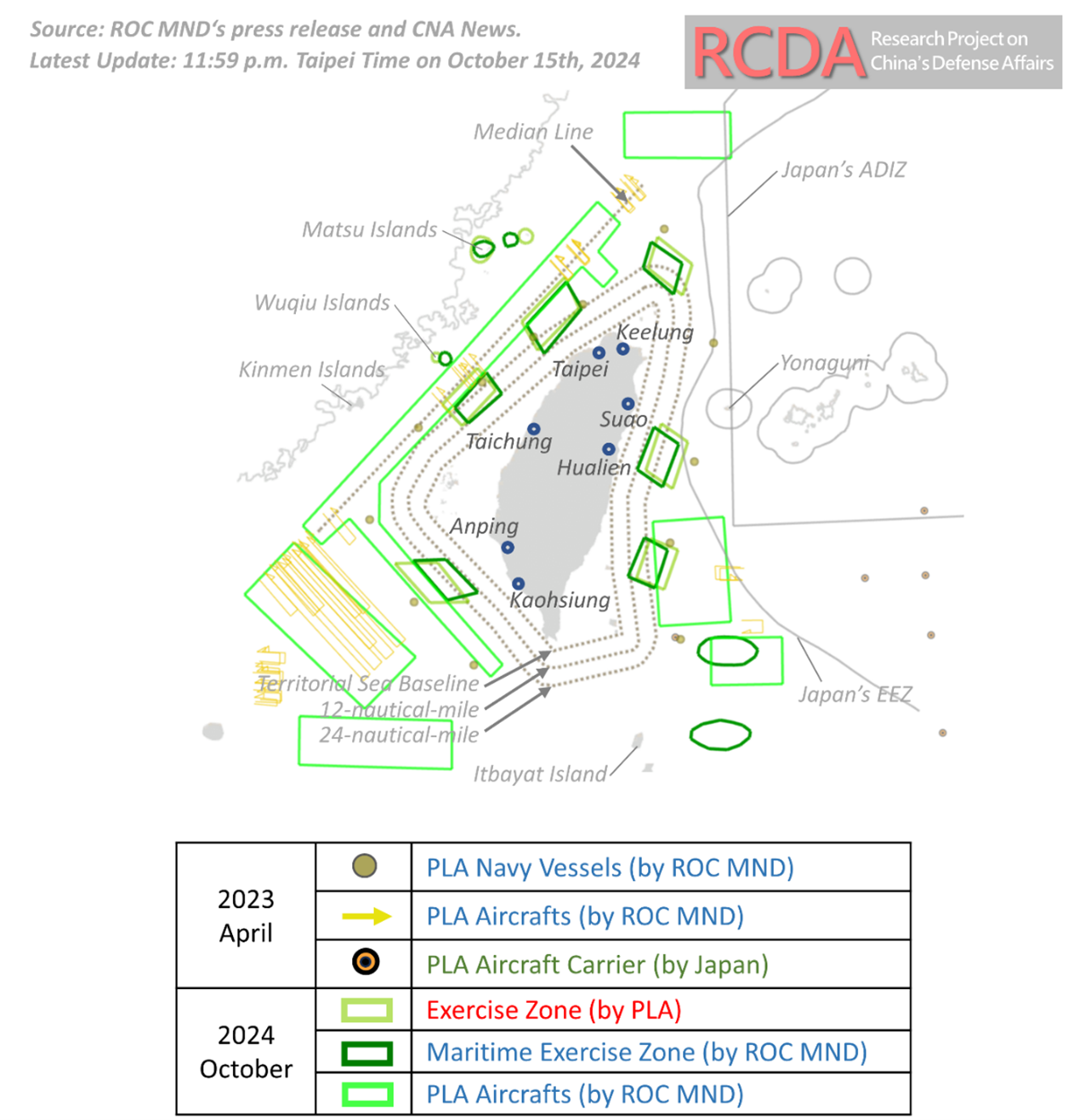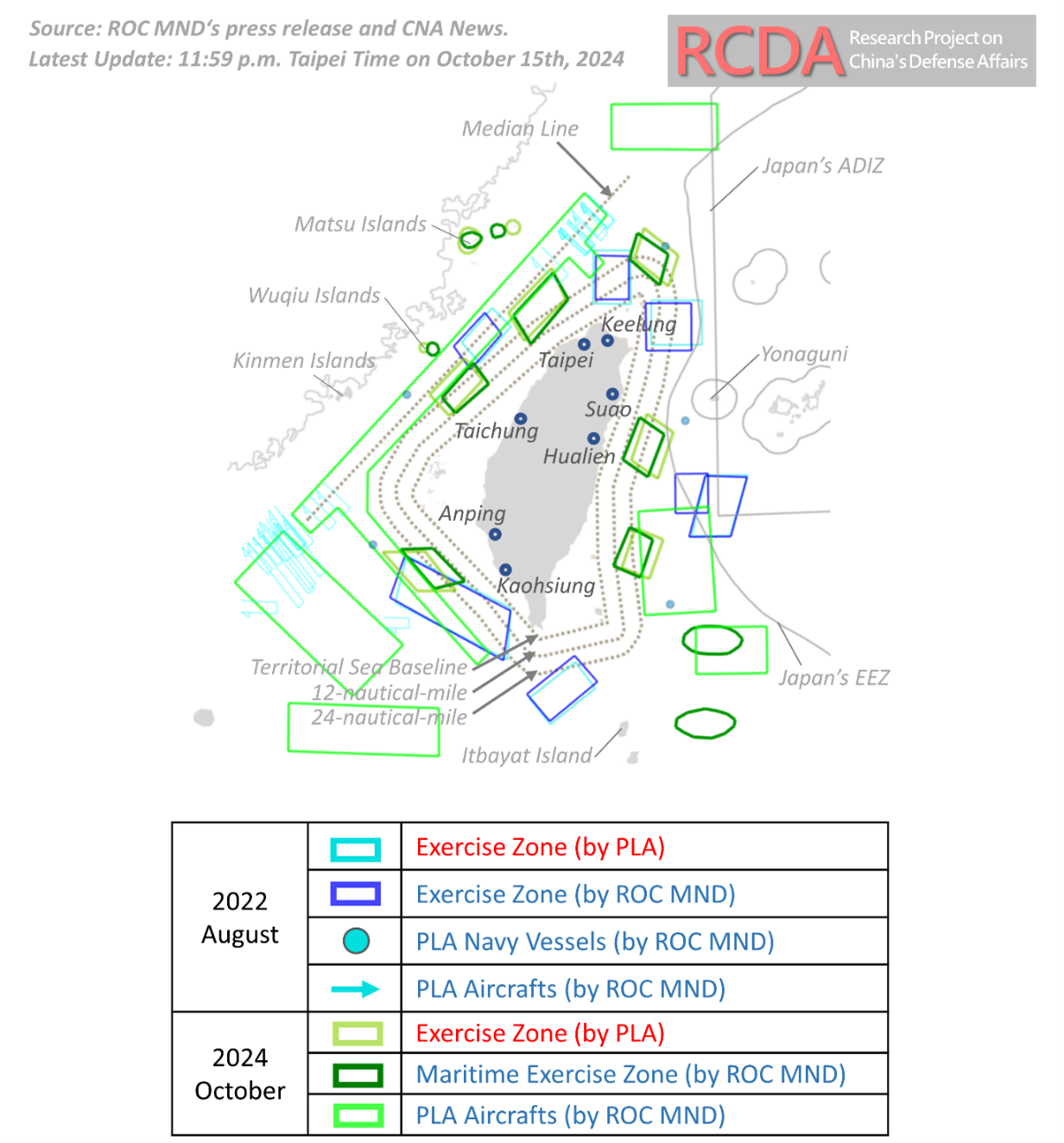Joint Sword-2024B: Quarantining Key Ports and Seizing Comprehensive Superiority
By Cheng-kun Ma, K. Tristan Tang
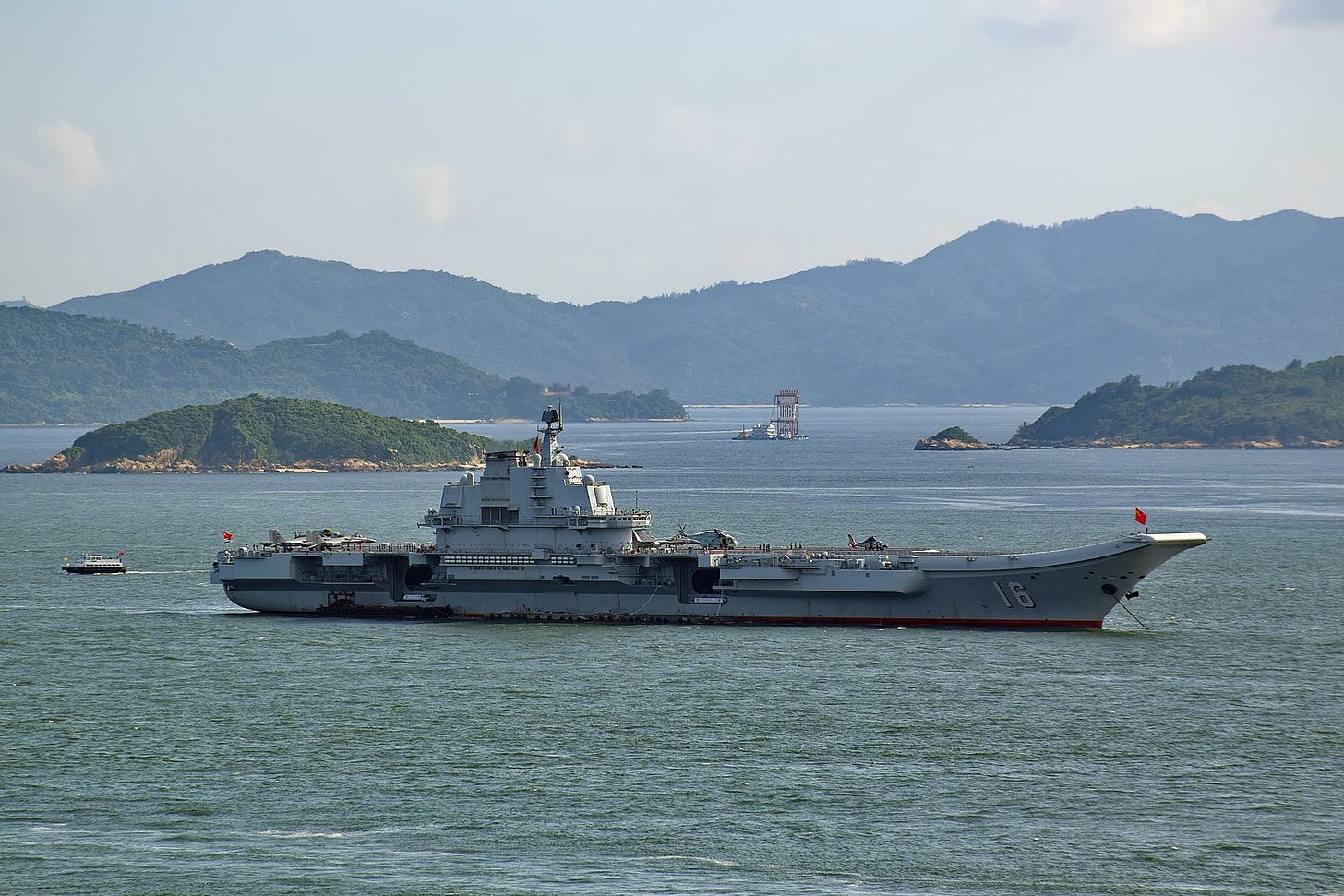
Executive Summary:
The Joint Sword-2024B exercise on October 14 focused on quarantining Taiwan’s ports and establishing sea and air superiority. It showcased the ability of the People’s Liberation Army (PLA) to coordinate maritime control with China Coast Guard (CCG) assets.
“2024B” was the fourth exercise in the last three years. Each has moved progressively closer to Taiwan and increased in intensity—October 14 saw the PLA Air Force conduct at least 153 sorties, the highest in a single day, and the exercise involved the most naval vessels of any to date.
CCG vessels activated their AIS tracking signals, in a bid to intimidate, but also to routinize their patrols as part of the PRC’s jurisdictional claims in the Taiwan Strait.
From 5:01 a.m. local time onward on October 14, information releases emerged from state media outlets in the People’s Republic of China (PRC) concerning the “Joint Sword-2024B (联合利剑-2024B)” exercise. These asserted that the People’s Liberation Army (PLA) Eastern Theater Command had organized forces from the army, navy, air force, and rocket force to conduct operations in the Taiwan Strait, as well as in the northern, southern, and eastern waters surrounding Taiwan. The key areas of focus for the exercise, according to the reports, included “sea-air combat-readiness patrol, a blockade on important ports and areas, an assault on maritime and ground targets, and joint seizure of comprehensive superiority (海空战备警巡、要港要域封控、对海对陆打击、夺取综合制权),” all aimed at testing the joint operational capabilities of theater forces (Xinhua, October 14; China Military Online, October 14).
A 8:00 a.m. on the same day, the China Coast Guard (CCG; 中国海警局) simultaneously released information on its official website and Weibo account, indicating that four groups of CCG vessels conducted patrol operations around Taiwan (China Coast Guard, October 14; Weibo/China Coast Guard, October 14). At 6:06 p.m. that evening, Xinhua News Agency announced that the PLA Eastern Theater Command had successfully concluded the exercise (Xinhua, October 14).
This exercise was anticipated. The inauguration of Taiwan’s President Lai Ching-te (賴清德) in May was also followed by a military exercise. Labeled “Joint Sword-2024A,” it implied follow-up exercises later in the year, as analysts noted at the time (China Brief, July 26). A week prior to the most recent exercise, Reuters reported that internal security memoranda from Taiwan’s government indicated that its leadership believed Beijing might attribute the exercise to perceived “provocations” in President Lai’s National Day speech on October 10 (Reuters, October 7). His speech was consequently met with criticism from various PRC government departments (China Brief, October 18). A day before the exercise, national security officials in Taiwan privately informed local media that they had already detected unusual military activities by the PLA and assessed the likelihood of imminent exercises as high, prompting preemptive preparations. These unusual activities included the PLA aircraft carrier Liaoning transiting eastward through the Bashi Channel into the Pacific, as well as four CCG vessels from the East China Sea Sub-Bureau navigating southward from Taiwan’s northeastern waters (LTN, October 13; October 17).
Exercise Rehearses Seizure of Comprehensive Superiority
Some of the four areas of focus outlined by PRC authorities have been observed in previous exercises. These include sea-air combat-readiness patrols and assaults on maritime and ground targets. Other aspects are relatively new, such as the blockade on key ports and areas and the joint seizure of comprehensive superiority. As such, these latter areas of focus warrant particular attention.
The quarantine on key ports appears to have been the primary focus of this military exercise. The PLA Navy (PLAN; 中国海军) was responsible for carrying out the blockade against naval vessels. The CCG, meanwhile, conducted quarantine operations targeting non-military ships with a view to controlling maritime traffic and inspecting cargo entering and leaving Taiwan’s ports.
The Joint Sword-2024B exercise encompassed a total of six operational areas in Taiwan’s northern, northwestern, southwestern, and eastern regions, and involved four Coast Guard vessel formations, according to images released by Xinhua News Agency and the CCG (Xinhua, October 14; CCG, October 14). To accomplish the objective of blockading and quarantining key ports, the operational zones were located outside Taiwan’s international commercial ports, which include Keelung, Taipei, Taichung, Anping, Kaohsiung, Hualien, and Su’ao (Executive Yuan, March 29). An update on the exercise released by the Ministry of National Defense (MND) of the Republic of China (ROC) as of 4:00 p.m. on October 14, along with subsequently published information on PLA aircraft activities on the morning of October 15, is shown in Figure 1 below (LTN, October 14; MND, October 15).
According to automatic identification system (AIS) data, six CCG vessels belonging to the first division of the East China Sea Sub-Bureau were tasked with quarantining the ports of Keelung, Kaohsiung, and Anping. They effectively demonstrated their ability to control the southeastern and northern ends of the median line in the Taiwan Strait. Additionally, among the six CCG vessels from the second division of the East China Sea Sub-Bureau, two patrolled within the Taiwan Strait, while four thousand-ton-class vessels (including the over ten-thousand-ton CCG 2901) were assigned to patrol the eastern waters of Taiwan. This suggests that one of the PRC’s aims was to showcase and practice the ability of CCG vessels to coordinate with the PLAN in quarantining Taiwan from international maritime traffic, with specific vessels from different divisions and of varying tonnage designated for exclusive missions.
The concept of a “blockade on key areas” has been widely discussed in the past, but Joint Sword-2024B represented a culmination of the PLA’s efforts to seize critical locations for an assault on Taiwan, at a scale unseen in previous iterations of the exercises. For a long time, Taiwan’s air and naval forces have regarded the eastern part of the island as a key area for force preservation. For instance, the ROC Air Force has established cave hangars in Hualien and Taitung—the latter intended to house the 66 new F-16 Block 70 aircraft purchased from the United States. Meanwhile, the ROC Navy intends to relocate its forces to the eastern waters of Taiwan prior to the onset of cross-strait war (CNA, September 23, 2019; LTN, July 22; RW News, May 13, 2022).
The deployment of PLA forces in eastern Taiwan is intended to demonstrate the capability of the PRC’s air and naval forces to control that area. During the exercise, the PLAN had eight vessels operating in the eastern waters of Taiwan, alongside the aircraft carrier Liaoning and at least two destroyers from the Liaoning group, which are positioned east of the Bashi Channel (LTN, October 14; Ministry of Defense of Japan Joint Staff Office, October 15).
The PLA Northern Theater Command also participated in the exercise. Since September, a naval formation consisting of two destroyers, one frigate, and one supply ship has been conducting a mission around Japan. On October 14, this formation navigated to within approximately 100 nautical miles east of the Liaoning task force, and did not proceed northward through the Miyako Strait back to the East China Sea until October 15, following the end of the exercise (Joint Staff of Japan, October 15). It is unclear what purpose it served, though it is possible it simulated an adversary for the Liaoning group. Regardless of the reason for its involvement, the presence of at least 15 PLAN vessels in the eastern waters of Taiwan on October 14—equivalent to over half of Taiwan’s naval fleet of 26 destroyers and frigates—constituted a number of vessels and level of combat power far exceeding what is usually found around in the area. This indicates that Taiwan’s intended force preservation zone must now contend with the threat of numerous PLA vessels during wartime, resulting in a severe compression of available combat power and posing a substantial threat to the likelihood of successful naval relocation operations.
Joint Sword-2024B involved almost all elements of operations to seize comprehensive superiority. Aside from electromagnetic and land superiority, which were difficult to observe in this exercise, the PLA clearly focused on establishing maritime and air superiority. The PLA Air Force (PLAAF) conducted at least 153 sorties (the highest in a single day recorded by Taiwan) in the vicinity of the island, with aircraft active in western Taiwan from 5:00 a.m. to just before 9:00 p.m.—roughly 16 continuous hours of PRC aircraft presence.
The exercise sought to enhance the realism of an operation to “seize comprehensive superiority.” PLA aircraft were launched from second-line—rather than frontline—airfields in the PRC, flew directly to designated locations near Taiwan, and then returned to their original or alternate airfields. This approach rehearsed a contingency in which frontline airfields are targeted and destroyed in the event of conflict, requiring the use of second-line airfields to ensure operational stability and safety. For the main combat aircraft, this exercise was conducted using a “full payload, full ammunition, and full fuel (全挂载、全弹量、全油量)” configuration. Upon returning to base, the aircraft immediately underwent ammunition unloading, the reloading of various munitions, and refueling, before swiftly flying back out to conduct military operations within Taiwan’s air defense identification zone (ADIZ). This operational model allows for “up to five resupply missions for attacks on Taiwan, depending on the mission type of each aircraft,” according to people familiar with the matter (RW News, October 17).
The deployment of naval assets from the Northern Theater Command’s Navy alongside those from the Eastern Theater Command indicates efforts to seize maritime superiority. Beyond the four vessels mentioned above, the Northern Theater Command’s contribution included two destroyers from the Liaoning carrier group itself. In total, 20 naval vessels were observed, including 15 in the eastern waters of Taiwan, and five in its western waters. Coupled with the PRC’s significant number of land-based anti-ship missiles, the deployment of 20 PLAN ships suggests that any plan for an assault on Taiwan would first involve the incapacitation of the Taiwanese Navy, before establishing comprehensive maritime control.
The PRC’s discussion of comprehensive superiority also encompasses the cognitive domain. The Political Work Department of the PLA views cognitive operations as crucial to its military strategy, considering it to be foundational to achieving other forms of superiority and, therefore, comprehensive superiority. Mastering cognitive superiority equates to controlling the critical junctures of battlefield authority, and is seen as the “key to victory (走向胜利的 ‘命门’)” (China Brief, September 6, 2019; PLA Daily, April 19, 2022).
Throughout most of the exercise, 11 of the 12 CCG ships involved continued to transmit their AIS signals (CCG 2901 only activated its AIS when departing the eastern waters of Taiwan after completing its mission). This is in stark contrast to the previous “Joint Sword” exercise in May, where none did so. Keeping their trackers on during the latest exercise served two purposes. First, the deliberate activation of AIS allowed the PRC to broadcast to the world the PRC’s ability to quarantine Taiwan, while also intimidating Taiwanese citizens. Second, as a country’s official vessels may activate AIS during lawful routine enforcement, doing so in this case allows the PRC to assert the legitimacy of its actions and continue to normalize its claims of “jurisdiction” over the waters surrounding Taiwan (China Brief, September 20). Of note, the effectiveness of the CCG’s quarantine operations relies heavily on the presence and support of the PLAN, as CCG inspections and patrol missions can only be carried out unhindered and without risk when the PLAN is able to blockade other naval forces.
‘2024B’ Saw Increase in Intensity, Proximity to Taiwan
A comparison of Joint Sword-2024B with three other PLA military exercises around Taiwan that have occurred since 2022 shows that each exercise has had different objectives. These include the two other “Joint Sword” exercises in April 2023 and May 2024, as well as those that followed Speaker of the US House of Representatives Nancy Pelosi’s trip to Taiwan in August 2022.
There are important elements of continuity between the first and second rounds of exercises in 2024, as both belong to successive phases of PLA operations around Taiwan, but each has had different areas of focus. The principal aim of the “2024A” exercise was to seize the initiative in the Taiwan Strait battlefield, with specific training content aimed at joint precision strikes on critical land, air, and maritime targets, as well as penetrating areas close to Taiwan’s air and maritime jurisdictional zones (CCTV, May 23). This represented the initial phase of an invasion of Taiwan, where swift action would be necessary to incapacitate Taiwan’s military capabilities.
Both of this year’s exercises also focused on seizing comprehensive superiority. However, the intensity of efforts in this direction was notably higher in the more recent exercise. For instance, the 153 sorties by the PLAAF on a single day in “2024B” far exceeded the maximum of 62 sorties in “2024A.” Exercise “2024A” also did not involve the participation of any PLA aircraft carrier group.
The focus on executing a blockade of ports and key areas after achieving a certain level of maritime and aerial superiority was also absent in the earlier exercise. During “2024A,” CCG ships did not explicitly patrol outside Taiwan’s international ports, nor did they activate their AIS to demonstrate the enforcement of their “jurisdiction.” Rehearsal of these aspects was much more deliberate during “2024B.”
The first “Joint Sword” exercise, held in April 2023, also shared elements in common with the two successive sets of exercises. As in “2024B,” last year’s exercise featured the Shandong aircraft carrier task force conducting anti-access/area denial (A2/AD) operations in the Western Pacific. However, the most recent exercise took place much closer to Taiwan than those in 2023. This was primarily because the 2023 exercise was focused on creating an all-around pressure situation by having the PLAN and PLAAF synchronize their operations to conduct patrols surrounding Taiwan, and to coordinate in the eastern waters of Taiwan with the Shandong aircraft carrier group located in the Philippine Sea (People’s Daily, April 11, 2023). In other words, the objective for 2023 was to achieve control over A2/AD operations “beyond Taiwan” in the Pacific. This meant emphasizing precise strikes and multidimensional control capabilities, which resulted in PLAN vessels being stationed further from Taiwan to deter external intervention. In contrast, “2024B” focused on port and area control, and so was directed “toward Taiwan,” with air, naval, and CCG forces deployed at closer ranges to the island.
Of the three exercises, the one conducted around Taiwan in August 2022 did the most to instill fear among the Taiwanese populace, aiming to deter public support for Taiwanese independence. The PLA Rocket Force launched 11 Dongfeng-15 missiles at Taiwan’s northern, eastern, and southern regions to assess precision strike and area denial capabilities (CNA, August 4, 2022; Xinhua, August 4, 2022; China Brief, August 12, 2022). Subsequently, the PLA Eastern Theater Command continued to conduct realistic joint training operations in the northern, southwestern, and eastern air and maritime domains surrounding Taiwan, aimed at enhancing joint operational capabilities between theater commands. At this early stage, the language used in official PRC media depicted the exercises as being conducted for training purposes and focusing on improving core combat capabilities (Xinhua, August 5, 2022). This differs from the more mature training exercise seen in “2024B.”Reviewing the arc of the PRC’s military exercises over the last three years shows that each has progressively moved closer to Taiwan. As such, although the most recent exercise had the shortest duration, the pressure on Taiwan’s space and the degree of military threat may be judged to have been at its highest. Notably, during the Joint Sword-2024A exercise, the operational areas published by Taiwan were farther from the island than those announced by the PLA itself. In contrast, those reported by Taiwan for the “2024B” exercise were closer to the island than those disclosed by the PLA.
Particularly concerning is the CCG’s increasing claims to “jurisdiction” in Taiwan’s waters, whereby Taiwan’s maritime traffic is subject to investigation by PRC vessels. Another worrying development is that the force preservation zone for Taiwan’s air and naval forces in the eastern region is no longer secure. This constitutes a severe threat to Taiwan, both in peacetime and during potential conflict—a marked change from previous years.
Conclusion
The three “Joint Sword” exercises to date have been unified in their focus on training for an assault on Taiwan. This continuity suggests that subsequent exercises in this series could further test the PRC’s real combat capabilities related to amphibious assault operations against Taiwan. Already, the PLA’s joint readiness patrols frequently involve 5,000-ton-class Type 072 amphibious landing ships (LTN, October 17). In the future, should the PLA conduct larger-scale amphibious landing operations, it may deploy Type 075 amphibious assault ships to conduct multidimensional landings aimed at seizing Taiwan’s offshore islands, rather than merely focusing on traditional amphibious landings.
The views expressed are solely those of the authors and do not represent the positions of the National Defense University, the Ministry of National Defense, or the government of ROC (Taiwan).
This article originally appeared in China Brief. Check it out here!
Cheng-kun Ma is a professor at the National Defense University, ROC (Taiwan), and the director of the Research Project on China’s Defense Affairs (RCDA). His research focuses on the People’s Liberation Army and China’s security strategy. Dr. Ma holds his Ph.D. in political science from the National Taiwan University.
K. Tristan Tang is a research associate at the Research Project on China’s Defense Affairs (RCDA). His research focuses on China’s defense industry, the People’s Liberation Army, and Chinese foreign policy.


